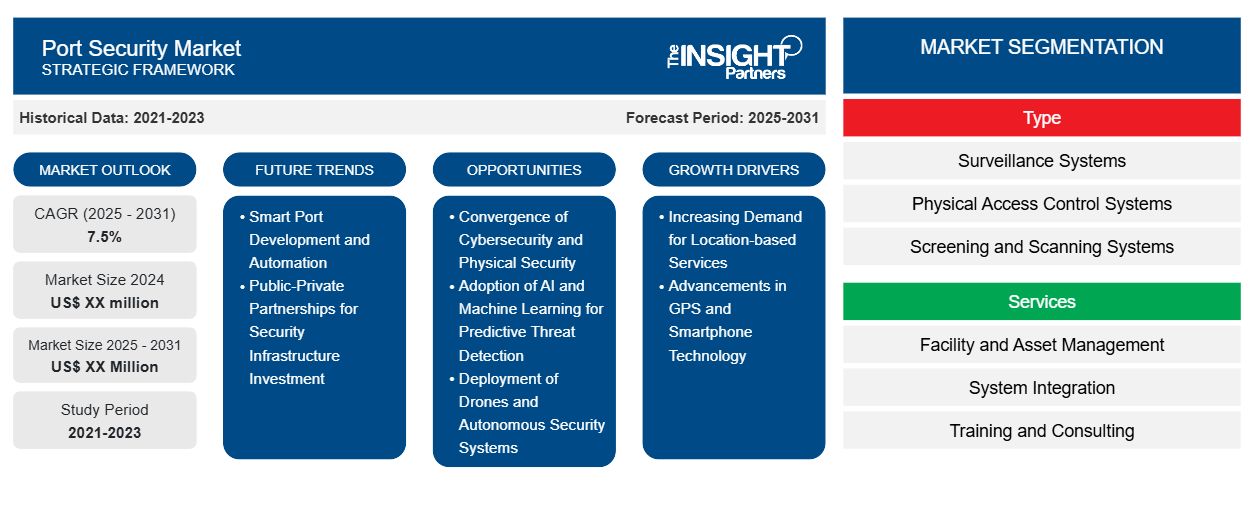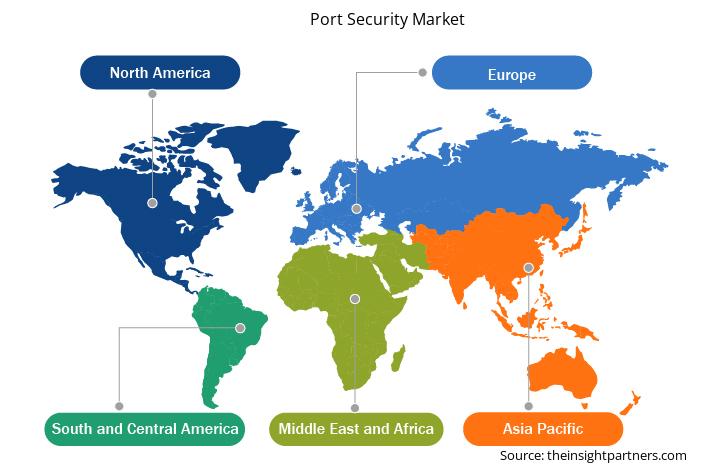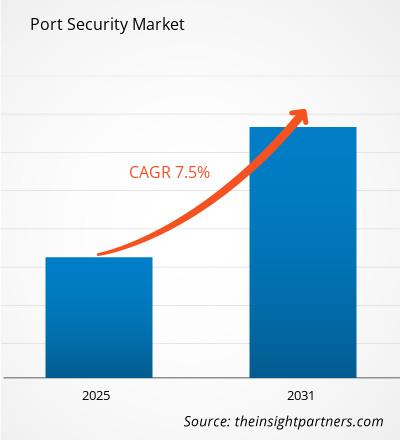港湾セキュリティ市場は、2025年から2031年にかけて7.5%のCAGRで成長し、市場規模は2024年のXX百万米ドルから2031年にはXX百万米ドルに拡大すると予想されています。
本レポートは、タイプ(監視システム、物理アクセス制御システム、スクリーニングおよびスキャンシステム、境界侵入検知システム、リアルタイム位置情報システム)およびサービス(施設・資産管理、システム統合、トレーニングおよびコンサルティング)別にセグメント化されています。グローバル分析は、地域レベルおよび主要国別にさらに細分化されています。本レポートでは、上記の分析およびセグメントの米ドル建て価値を提供しています。
報告書の目的
The Insight Partnersによる港湾セキュリティ市場レポートは、現状と将来の成長、主要な推進要因、課題、そして機会を解説することを目的としています。これにより、以下のような様々なビジネスステークホルダーに洞察を提供します。
- テクノロジープロバイダー/メーカー: 進化する市場の動向を理解し、潜在的な成長機会を把握することで、情報に基づいた戦略的意思決定を行うことができます。
- 投資家: 市場の成長率、市場の財務予測、バリュー チェーン全体に存在する機会に関する包括的な傾向分析を実施します。
- 規制機関: 市場の濫用を最小限に抑え、投資家の信用と信頼を維持し、市場の健全性と安定性を維持することを目的として、市場における政策と警察活動を規制します。
港湾セキュリティ市場のセグメンテーション
タイプ
- 監視システム
- 物理アクセス制御システム
- スクリーニングおよびスキャンシステム
- 境界侵入検知システム
- リアルタイム位置情報システム
サービス
- 施設および資産管理
- システム統合
- トレーニングとコンサルティング
要件に合わせてレポートをカスタマイズ
このレポートの一部、国レベルの分析、Excelデータパックなど、あらゆるレポートを無料でカスタマイズできます。また、スタートアップや大学向けのお得なオファーや割引もご利用いただけます。
港湾セキュリティ市場:戦略的洞察

- このレポートの主要な市場動向を入手してください。この無料サンプルには、市場動向から見積もりや予測に至るまでのデータ分析が含まれます。
港湾セキュリティ市場の成長要因
- 位置情報サービスへの需要増加:位置情報サービス(LBS)の急速な普及は、モバイルマッピング市場の主要な牽引力となっています。企業や消費者がリアルタイムナビゲーション、地理空間分析、位置情報マーケティングを求める中、モバイルマッピングアプリケーションは不可欠なものとなっています。配送サービス、ナビゲーションアプリ、パーソナライズされた位置情報データなど、正確で信頼性の高いモバイルマッピングソリューションへの需要は高まっており、運輸、小売、物流など、様々な業界でこれらのテクノロジーの需要が高まっています。geospatial analytics, and location-based marketing, mobile mapping applications have become essential. Whether for delivery services, navigation apps, or personalized location data, the need for accurate and reliable mobile mapping solutions is rising, leading to greater demand for these technologies in various industries like transportation, retail, and logistics.
- GPSとスマートフォン技術の進歩:GPS技術とスマートフォン機能の継続的な進歩が、モバイルマッピング市場を牽引しています。加速度計、ジャイロスコープ、カメラなどのセンサーの精度、速度、そして統合性の向上により、モバイルマッピングアプリケーションの機能が向上しています。これらのイノベーションにより、より正確な測位、マッピング、そしてユーザーエクスペリエンスの向上が実現し、モバイルマッピングソリューションの信頼性と効率性が向上し、市場の成長を加速させています。
港湾セキュリティ市場の将来動向
- スマートポートの開発と自動化:自動化とデジタル化によって港湾が近代化されるにつれ、これらの新技術を補完する高度なセキュリティシステムを統合する大きな機会が生まれています。スマートポートは、センサー、IoT、データ分析を活用して港湾運営を最適化します。これらの技術とセキュリティソリューションを統合することで、運用効率とセキュリティの両方をシームレスに管理できます。スマートポートへの移行は、物理的なセキュリティを監視するだけでなく、サイバー脅威からデジタルインフラを保護する、高度な統合セキュリティシステムの需要を生み出します。
- セキュリティインフラ投資のための官民パートナーシップ:高度な港湾セキュリティシステムの開発と維持には多額の費用がかかるため、官民パートナーシップ(PPP)は有望な機会となります。政府は民間セキュリティ企業と協力し、監視システム、ドローン、AIベースの脅威検知といった先進技術の資金調達、導入、管理を行うことができます。このモデルは、港湾のセキュリティを確保しながら財政負担のバランスをとるのに役立ちます。PPPが普及するにつれて、セキュリティ技術を専門とする民間企業は長期契約の恩恵を受け、新たな収益源を開拓できるようになります。
港湾セキュリティ市場の機会
- サイバーセキュリティと物理セキュリティの融合:港湾の相互接続とデジタル技術への依存が高まるにつれ、サイバーセキュリティと物理セキュリティの融合が重要なトレンドになりつつあります。港湾システムへのサイバー攻撃は、物流、航行、そして業務に甚大な被害をもたらす可能性があります。そのため、港湾当局は、物理的防御策とサイバー防御策を組み合わせた統合セキュリティシステムの導入を加速させています。この傾向は、貨物、船舶、施設などの物理的資産と、通信システム、自動化制御などのデジタルインフラの両方を保護できる高度なセキュリティソリューションの必要性が高まっていることを浮き彫りにしています。
- 予測的脅威検知のためのAIと機械学習の導入:港湾セキュリティにおいて、人工知能(AI)と機械学習(ML)の活用が主流になりつつあります。これらの技術により、カメラ、センサー、船舶追跡システムなど、複数のソースから得られるデータをリアルタイムで分析し、潜在的なセキュリティ脅威を予測・検知することが可能になります。AIを活用したアルゴリズムは、人間のオペレーターが見逃してしまう可能性のある大規模なデータセット内のパターンや異常を特定し、セキュリティインシデントが深刻化する前にプロアクティブな対応を可能にします。このトレンドは、港湾におけるリスクの監視と管理方法に革命をもたらし、より安全で効率的な港湾を実現します。
- ドローンと自律型セキュリティシステムの導入:港湾警備におけるドローンと自律型セキュリティシステムの活用が加速しています。ドローンは、監視、貨物やインフラの点検、そしてアクセス困難な地域での船舶の動静監視などにますます活用されています。同様に、自律走行車やロボットは、貨物検査や境界警備といった業務に導入され、人的介入の必要性を減らし、全体的なセキュリティ対応時間を向上させています。この傾向は、港湾警備業務の効率性を高め、コストと人的ミスを削減するために、自動化への依存度が高まっていることを浮き彫りにしています。
港湾セキュリティ市場の地域別分析
予測期間全体を通して港湾セキュリティ市場に影響を与える地域的な傾向と要因は、Insight Partnersのアナリストによって徹底的に説明されています。このセクションでは、北米、ヨーロッパ、アジア太平洋、中東・アフリカ、中南米における港湾セキュリティ市場のセグメントと地域についても説明します。

- 港湾セキュリティ市場の地域別データを入手
港湾セキュリティ市場レポートの範囲
| レポート属性 | 詳細 |
|---|---|
| 2024年の市場規模 | XX百万米ドル |
| 2031年までの市場規模 | XX百万米ドル |
| 世界のCAGR(2025年~2031年) | 7.5% |
| 履歴データ | 2021-2023 |
| 予測期間 | 2025~2031年 |
| 対象セグメント | タイプ別
|
| 対象地域と国 | 北米
|
| 市場リーダーと主要企業の概要 |
|
港湾セキュリティ市場のプレーヤー密度:ビジネスダイナミクスへの影響を理解する
港湾セキュリティ市場は、消費者の嗜好の変化、技術の進歩、製品メリットへの認知度の向上といった要因によるエンドユーザーの需要増加に牽引され、急速に成長しています。需要の増加に伴い、企業は製品ラインナップの拡充、消費者ニーズへの対応のための革新、そして新たなトレンドの活用を進めており、これが市場の成長をさらに加速させています。
市場プレーヤー密度とは、特定の市場または業界内で事業を展開する企業または会社の分布を指します。これは、特定の市場空間における競合企業(市場プレーヤー)の数が、その市場規模または市場価値全体と比較してどれだけ多いかを示します。
港湾セキュリティ市場で事業を展開している主要企業は次のとおりです。
- テレダインFLIR LLC
- ジョンソンコントロールズ
- ハネウェルインターナショナル株式会社
- サーブAB
- ロバート・ボッシュGmbH
- シーメンスAG
免責事項:上記の企業は、特定の順序でランク付けされているわけではありません。

- 港湾セキュリティ市場のトップキープレーヤーの概要を入手
主なセールスポイント
- 包括的なカバレッジ:レポートでは、港湾セキュリティ市場の製品、サービス、タイプ、エンドユーザーの分析を包括的にカバーし、全体的な展望を提供します。
- 専門家の分析:レポートは、業界の専門家とアナリストの深い理解に基づいて作成されています。
- 最新情報: このレポートは、最新の情報とデータの傾向を網羅しているため、ビジネスの関連性を保証します。
- カスタマイズ オプション: このレポートは、特定のクライアント要件に対応し、ビジネス戦略に適切に適合するようにカスタマイズできます。
したがって、港湾セキュリティ市場に関する調査レポートは、業界の状況と成長見通しを解明し、理解するための先導役となるでしょう。いくつかの妥当な懸念事項はあるものの、このレポートの全体的なメリットはデメリットを上回る傾向にあります。
- 過去2年間の分析、基準年、CAGRによる予測(7年間)
- PEST分析とSWOT分析
- 市場規模価値/数量 - 世界、地域、国
- 業界と競争環境
- Excel データセット
最新レポート
関連レポート
お客様の声
購入理由
- 情報に基づいた意思決定
- 市場動向の理解
- 競合分析
- 顧客インサイト
- 市場予測
- リスク軽減
- 戦略計画
- 投資の正当性
- 新興市場の特定
- マーケティング戦略の強化
- 業務効率の向上
- 規制動向への対応




















 無料サンプルを入手 - 港湾セキュリティ市場
無料サンプルを入手 - 港湾セキュリティ市場